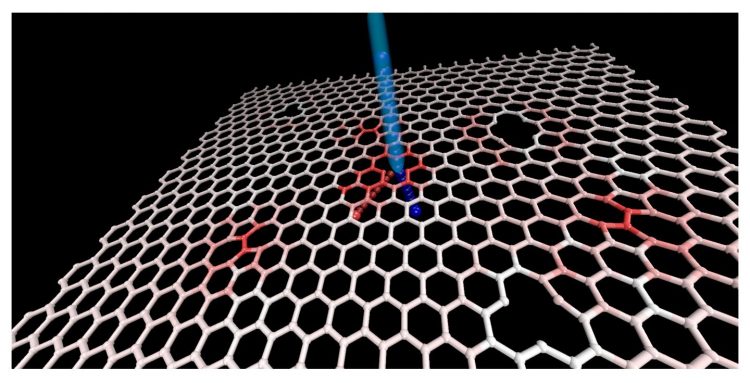Simulations show how to turn graphene's defects into assets

This is the simulated collision path of a Krypton-ion (blue) with a defected graphene sheet and subsequent formation of a carbon vacancy (red). Red color shading indicates local strain in the graphene. Credit: Kichul Yoon, Penn State
For a two-dimensional, one-atom-thick material like graphene, defects such as small cracks or holes can make a big difference in performance. Usually, these defects are considered undesirable. But if the defects can be controlled, they can be used to engineer new, desirable properties into the material.
“As long as you can control defects, you might be able to synthesize into graphene whatever kinds of response the graphenematerial will give you,” said Adri van Duin, Kenneth Kuan-Yo Kuo Early Career Professor and professor of mechanical engineering and chemical engineering, Penn State and corresponding author on a recent paper in ACS Nano. “But that does require that you have very good control over defect structure and defect behavior. What we have done here is a pretty strong step towards that.”
van Duin is the co-inventor and main developer of a mathematical modeling and simulation technique called the Reactive Force Field Method (ReaxFF), which is capable of predicting the interactions of thousands of atoms when they are perturbed by an external force, in this case the bombardment of graphene by noble gas atoms.
Noble gases — helium, neon, argon, krypton and xzenon– are frequently used to create defects in graphene to enhance its properties. By knocking one or more carbon atoms out of graphene's chicken wire-shaped structure, the resulting hole can be filled by atoms of another material or by specific molecules in a process called doping. Doping can change the chemical or electrical properties of the graphene to, to, for example, allow water molecules to flow through a membrane while rejecting salt particles.
“We have done a series of atomistic scale simulations where we accelerate noble gas ions into the graphene,” said van Duin who is also director, Materials Computation Center, part of the user facility of Penn State's Materials Research Institute. “The simulations gave much the same defect patterns as experiments. That means our simulations can tell experimentalists what dose of atoms at which acceleration they need to get those types of defects.”
Because defects can morph into different shapes or move around in the seconds after creation, his group also simulates putting the graphene in an oven and annealing — heating at high temperature — to stabilize the structure.
It is unusual for an atomistic simulation to correspond to the same size, time and exposure range as an experiment due to the computational expense of doing interactions among thousands of atoms over the time scale required to stabilize a material, van Duin said. ReaxFF, developed by van Duin and Caltech's William A. Goddard, is able to model chemical and physical interactions in molecules and materials as bonds between atoms form and break.
“This study provides insight into the atomistic scale details of graphene irradiation and is a preliminary step in designing functionalized carbon materials in two dimensions,” said Kichuel Yoon, the paper's lead author and a graduate student in van Duin's group.
van Duin adds, “Clearly there is nothing that makes this exclusive to graphene. Any 2D material can be treated with the same simulations. Anyone who wants to dope a 2D material or understand defects will be interested in these simulations.”
The researchers intend to continue working with Lockheed Martin on aerospace applications and will also pursue the goal of graphene-based water desalination.
Jacob Swett of Lockheed Martin prepared the samples used in experiments and was crucial in moving the project forward.
To correlate simulations with experiments, the researchers relied upon the Center for Nanophase Materials Sciences, a Department of Energy Office of Science User Facility at ORNL, to create defects using ion bombardment and subsequently characterizing those defects using atomic-resolution imaging.
“At CNMS, we have state-of-the-art Helium and Neon ion beam and aberration-corrected scanning transmission electron microscopy instruments that permit atomistic scale characterization,” said Raymond Unocic, an R&D staff scientist at ORNL.
###
Raymond Unocic, senior scientist at Oak Ridge National Laboratory was responsible for the imaging. Other contributors to the paper, “Atomistic-Scale Simulations of Defect Formation in Graphene Under Noble Gas Ion Irradiation,” were Ali Rahnamoun, a Ph.D. student in van Duin's group, and Vighter Iberi, David Cullen, Stephen Jesse, Ivan Vlassiouk, Alex Belianinov, Xiahan Sang, Olga Ovchinnikova, and Adam Rondinone, all at ORNL, who contributed to the experimental modification and characterization of graphene.
The Fluid Interface Reactions, Structures and Transport Center, an Energy Frontier Research Center funded by the Office of Science, Office of Basic Energy Sciences, U.S. Department of Energy supported this work.
Media Contact
All latest news from the category: Physics and Astronomy
This area deals with the fundamental laws and building blocks of nature and how they interact, the properties and the behavior of matter, and research into space and time and their structures.
innovations-report provides in-depth reports and articles on subjects such as astrophysics, laser technologies, nuclear, quantum, particle and solid-state physics, nanotechnologies, planetary research and findings (Mars, Venus) and developments related to the Hubble Telescope.
Newest articles

Bringing bio-inspired robots to life
Nebraska researcher Eric Markvicka gets NSF CAREER Award to pursue manufacture of novel materials for soft robotics and stretchable electronics. Engineers are increasingly eager to develop robots that mimic the…

Bella moths use poison to attract mates
Scientists are closer to finding out how. Pyrrolizidine alkaloids are as bitter and toxic as they are hard to pronounce. They’re produced by several different types of plants and are…

AI tool creates ‘synthetic’ images of cells
…for enhanced microscopy analysis. Observing individual cells through microscopes can reveal a range of important cell biological phenomena that frequently play a role in human diseases, but the process of…





















